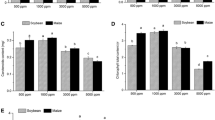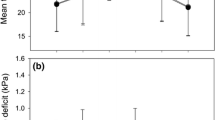Abstract
Four-year-oldPinus sylvestriformis were exposed for four growing seasons in open top chambers to ambient CO2 concentration (approx. 350 μmol·mol−1) and high CO2 concentrations (500 and 700 μmol·mol−1) at Research Station of Changbai Mountain Forest Ecosystems, Chinese Academy of Sciences at Antu Town, Jilin Province, China (42°N, 128°E). Stomatal response to elevated CO2 concentrations was examined by stomatal conductance (g s), ratio of intercellular to ambient CO2 concentration (c i/c a) and stomatal number. Reciprocal transfer experiments of stomatal conductance showed that stomatal conductance in high-[CO2]-grown plants increased in comparison with ambient-[CO2]-grown plants when measured at their respective growth CO2 concentration and at the same measurement CO2 concentration (except a reduction in 700 μmol·mol−1 CO2. grown plants compared with plants on unchambered field when measured at growth CO2 concentration and 350 μmol·mol−1CO2). High-[CO2]-grown plants exhibited lowerc i/c a ratios than ambient-[CO2]-grown plants when measured at their respective growth CO2 concentration. However,c i/c a ratios increased for plants grown in high CO2 concentrations compared with control plants when measured at the same CO2 concentration. There was no significant difference in stomatal number per unit long needle between elevated and ambient CO2. However, elevated CO2 concentrations reduced the total stomatal number of whole needle by the decline of stomatal line and changed the allocation pattern of stomata between upper and lower surface of needle.
Similar content being viewed by others
Abbreviations
- gs :
-
stomatal conductance
- ci :
-
intercellular CO2 concentration
- ca :
-
ambient CO2 concentration
References
Barton, C.V.M. and Jarvis, P.G. 1999. Growth response of branches ofPicea sitchensis to four years exposure to elevated atmospheric carbon dioxide concentration [J]. New Phytologist,144: 233–243.
Bunce, J.A. 2000. Responses of stomatal conductance to light, humidity and temperature in winter wheat and barley grown at three concentrations of carbon dioxide in the field [J]. Global Change Biology,6: 371–382.
Curtis, P.S. 1996. A meta-analysis of leaf gas exchange and nitrogen in trees grown under elevated carbon dioxide [J]. Plant, Cell and Environment,19: 127–137.
Drake, B.G., Gonzàlez-Meler, M.A. and Long, S.P. 1997. More efficient plants: a consequence of rising atmospheric CO2? [J]. Annual Review Plant Physiology and Plant Molecular Biology,48: 607–637.
Ellsworth, D.S. 1999. CO2 enrichment in a maturing pine forest: are CO2 exchange and water status in the canopy affected? [J]. Plant, Cell and Environment,22: 461–472.
Jarvis, A.J., Mansfield, T.A. and Davies, W.J. 1999. Stomatal behavior, photosynthesis and transpiration under rising CO2 [J]. Plant, Cell and Environment,22: 639–648.
Lodge, R.J., Dijkstra, P., Drake, B.G. and Morison, J.I.L. 2001. Stomatal acclimation to increased CO2 concentration in a Florida scrub oak speciesQuercus myrtifolia Willd [J]. Plant, Cell and Environment,24: 77–88.
Morison, J.I.L. 1998. Stomatal response to increased CO2 concentration [J]. Journal of Experimental Botany,49: 443–452.
Morison, J.I.L. 2001. Increasing atmospheric CO2 and stomata [J]. New Phytologist,149: 154–156.
Mott, K.A. 1998. Do stomata respond to CO2 concentrations other than intercellular? Plant Physiology,86: 200–203.
Mott, K.A. 1990. Sensing of atmospheric CO2 by plants [J]. Plant, Cell and Environment,13: 731–737.
Poole, I., Lawson, T., Weyers, J.D.B. and Raven, J.A. 2000. Effect of elevated CO2 on the stomatal distribution and leaf physiology of Alnus glutinosa [J]. New Phytologist,145: 511–521.
Sage, R.F. 1994. Acclimation of photosynthesis to increasing atmospheric CO2: the gas exchange perspective [J]. Photosynthesis Research,39: 351–368.
Saxe, H., Ellsworth, D.S. and Heath, J. 1998. Tree and forest functioning in an enriched CO2 atmosphere [J]. New Phytologist,139: 395–436.
Teskey, R.O. 1995. A field study of the effects of elevated CO2 on carbon assimilation, stomatal conductance and leaf and branch growth ofPinus taeda trees [J]. Plant, Cell and Environment,18: 565–573.
Weyers, J.D.B. and Lawson, T. 1997. Heterogeneity in stomatal characteristics [J]. Advances in Botanical Research,26: 317–352.
Wong, S.C. 1993. Interaction between elevated atmospheric concentration of CO2 and humidity on plant growth: Comparison between cotton and radish [J]. Vegetatio,104/105: 211–221.
Zhang, S.R., Ma, K.P. and Chen, L.Z. 2002. Tempo-Spatial variations in stomatal conductance, aperture and density ofLigustrum sinense acclimated to different light environments [J]. Acta Botany of Sinica,44: 1225–1232.
Author information
Authors and Affiliations
Corresponding author
Additional information
Foundation Item: This research was supported by National Basic Research Program of China (2002CB412502), Project of Key program of the National Natural Science Foundation of China (90411020) and National Natural Science Foundation of China (30400051).
Biography: ZHOU Yu-mei (1973-), female, Ph. Doctor, assistant research fellow, Institute of Applied Ecology, Chinese Academy of Sciences, Shenyang 110016, P. R. China.
Responsible editor: Song Funan
Rights and permissions
About this article
Cite this article
Yu-mei, Z., Shi-jie, H., Ying, L. et al. Stomatal response ofPinus sylvestriformis to elevated CO2 concentrations during the four years of exposure. Journal of Forestry Research 16, 15–18 (2005). https://doi.org/10.1007/BF02856846
Received:
Issue Date:
DOI: https://doi.org/10.1007/BF02856846




